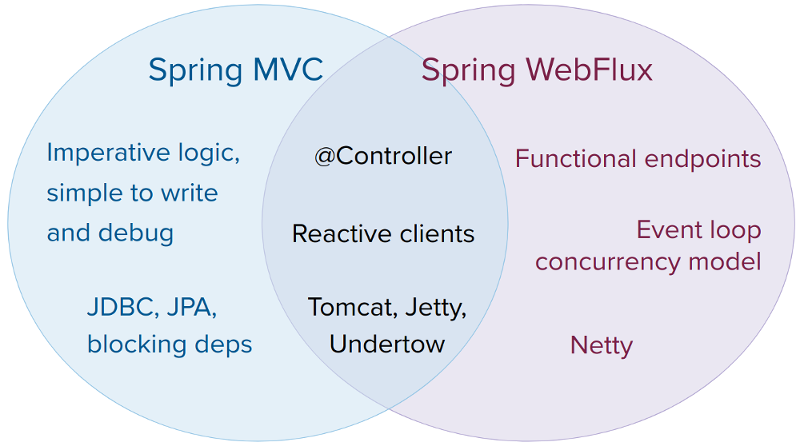简介
Spring WebFlux是Spring Framework 5.0中引入的新的反应式Web框架。 与Spring MVC不同,它不需要Servlet API,完全异步和非阻塞, 并通过Reactor项目实现Reactive Streams规范。 并且可以在诸如Netty,Undertow和Servlet 3.1+容器的服务器上运行。
Reactor中的Mono和Flux
Flux 和 Mono 是 Reactor 中的两个基本概念。Flux 表示的是包含 0 到 N 个元素的异步序列。 在该序列中可以包含三种不同类型的消息通知:正常的包含元素的消息、序列结束的消息和序列出错的消息。 当消息通知产生时,订阅者中对应的方法 onNext(), onComplete()和 onError()会被调用。Mono 表示的是包含 0 或者 1 个元素的异步序列。 该序列中同样可以包含与 Flux 相同的三种类型的消息通知。Flux 和 Mono 之间可以进行转换。 对一个 Flux 序列进行计数操作,得到的结果是一个 Mono对象。把两个 Mono 序列合并在一起,得到的是一个 Flux 对象。 了解更多
WebFlux的使用方式
如图所示,WebFlux支持两种编程方式
- 基于SpringMvc注解@Controller
- 基于Java8 lambda样式路由和处理
使用WebFlux需要单独引用它的依赖,我使用的springboot,依赖如下:
<dependency>
<groupId>org.springframework.boot</groupId>
<artifactId>spring-boot-starter-webflux</artifactId>
</dependency>
<!--reactor的测试依赖-->
<dependency>
<groupId>io.projectreactor</groupId>
<artifactId>reactor-test</artifactId>
<scope>test</scope>
</dependency>示例
-
基于SpringMvc注解
与使用SpringMvc不同的是使用SpringWebFlux同一使用Mono<>,Flux<>对象同意返回数据,如下
@RestController @RequestMapping("/api/user") public class WebFluxController { private Map<Long,User> map = new HashMap<Long,User>(10); @PostConstruct public void init(){ map.put(1L,new User(1,"admin","admin")); map.put(2L,new User(1,"admin2","admin2")); map.put(3L,new User(1,"admin3","admin3")); } @GetMapping("/getAll") public Flux<User> getAllUser(){ return Flux.fromIterable(map.entrySet().stream().map(Map.Entry::getValue) .collect(Collectors.toList())); } @GetMapping("/{id}") public Mono<User> getUserById(@PathVariable("id") Long id){ return Mono.just(map.get(id)); } @PostMapping("/save") public Mono<ResponseEntity<String>> save(@RequestBody User user){ map.put(user.getUid(),user); return Mono.just(new ResponseEntity<>("添加成功", HttpStatus.CREATED)); } }
具体实现代码可查看springboot-webflux
-
基于功能
处理请求的类,实现具体的业务逻辑,接口 ServerRequest 表示的是一个 HTTP 请求体。通过ServerRequest 对象可获取到请求的相关信息,如请求路径、查询参数和请求内容等。方法 的返回值是一个 Mono对象。接口 ServerResponse 用来表示 HTTP 响应。ServerResponse 中包含了很多静态方法来创建不同 HTTP 状态码的响应对象
@Component public class UserHandler { private IUserService userService; @Autowired public UserHandler(IUserService userService) { this.userService = userService; } public Mono<ServerResponse> getAllUser(ServerRequest serverRequest){ Flux<User> allUser = userService.getAllUser(); return ServerResponse.ok().contentType(MediaType.APPLICATION_JSON).body(allUser,User.class); } public Mono<ServerResponse> getUserById(ServerRequest serverRequest){ //获取url上的id Long uid = Long.valueOf(serverRequest.pathVariable("id")); Mono<User> user = userService.getUserById(uid); return ServerResponse.ok().contentType(MediaType.APPLICATION_JSON).body(user,User.class); } public Mono<ServerResponse> saveUser(ServerRequest serverRequest){ Mono<User> user = serverRequest.bodyToMono(User.class); return ServerResponse.ok().build(userService.saveUser(user)); } }
为Handler类添加路由信息,
@Configuration public class RoutingConfiguration { @Bean public RouterFunction<ServerResponse> monoRouterFunction(UserHandler userHandler){ return route(GET("/api/user").and(accept(MediaType.APPLICATION_JSON)),userHandler::getAllUser) .andRoute(GET("/api/user/{id}").and(accept(MediaType.APPLICATION_JSON)),userHandler::getUserById) .andRoute(POST("/api/save").and(accept(MediaType.APPLICATION_JSON)),userHandler::saveUser); } }
具体实现代码可查看springboot-webflux-functional 博客
